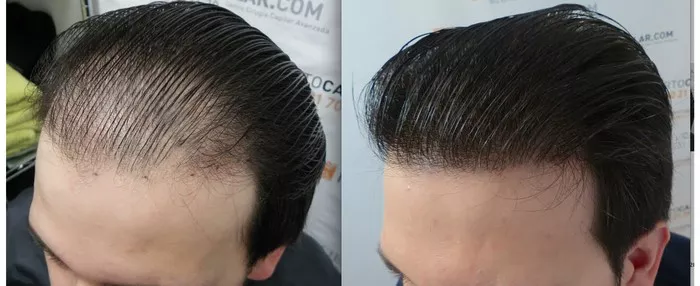Hair transplantation has become a popular solution for individuals seeking to restore a fuller head of hair and combat balding or thinning hair. While the procedure offers promising results in terms of regaining lost hair, questions often arise regarding the behavior of transplanted hair over time, particularly concerning graying. Understanding the nuances of hair transplantation and its relationship with the aging process can help individuals make informed decisions and manage expectations regarding the long-term outcome of the procedure.
Explanation of Hair Transplantation
Hair transplantation involves the extraction of hair follicles from a donor area, typically the back or sides of the scalp, and implanting them into areas experiencing hair loss. Two primary techniques used in hair transplantation are Follicular Unit Transplantation (FUT) and Follicular Unit Excision/Extraction (FUE).
In FUT, a strip of skin containing hair follicles is surgically removed from the donor area, and the follicular units are dissected and transplanted into the recipient area. FUE, on the other hand, involves individually extracting follicular units from the donor site using a specialized punch tool and then implanting them into the recipient area. Both techniques aim to achieve natural-looking results by mimicking the natural pattern of hair growth.
Aging of Transplanted Hair
One common misconception about transplanted hair is that it remains immune to the aging process. However, transplanted hair behaves like natural hair and undergoes the same aging changes over time. As individuals age, the hair follicles gradually produce less melanin, the pigment responsible for hair color. Consequently, transplanted hair from the donor area will also experience a reduction in melanin production, leading to the appearance of gray hair.
The rate at which transplanted hair turns gray varies among individuals and is primarily determined by genetics. Just as genetics play a significant role in determining the onset of natural hair graying, they also influence the timing of gray hair development in transplanted follicles. Other factors such as diet, lifestyle, and overall health can indirectly affect the graying process but are not as influential as genetic predisposition.
Genetics and Graying Process
Understanding the genetic basis of hair graying sheds light on why transplanted hair eventually turns gray. Research has identified several genes associated with hair color, including those involved in melanin production and distribution. Variations in these genes can influence the rate at which melanin is produced and the timing of hair graying.
The graying process typically begins with the gradual depletion of melanocytes, the cells responsible for producing melanin, within the hair follicles. As melanocyte activity declines, the hair loses its pigment and appears gray or white. While the exact mechanisms underlying this process are still being studied, it is clear that genetics play a central role in determining when and how rapidly hair graying occurs.
Transplanting Gray Hair
Given that transplanted hair reflects the characteristics of the donor area, it is indeed possible to transplant gray hair. However, there are some considerations and challenges associated with transplanting gray hair compared to pigmented hair.
One challenge is ensuring that the transplanted gray hair blends seamlessly with the existing hair in the recipient area. Since gray hair lacks pigment, achieving a natural-looking result may require careful planning and strategic placement of the transplanted follicles. Additionally, the texture and thickness of gray hair may differ from pigmented hair, which can impact the overall aesthetic outcome of the procedure.
Despite these challenges, advancements in hair transplantation techniques and technology have made it possible to achieve satisfactory results when transplanting gray hair. Experienced hair transplant surgeons can customize the procedure to meet the unique needs and preferences of each patient, ensuring a natural-looking and harmonious result.
Management of Expectations
It is essential for individuals considering hair transplantation to understand that transplanted hair is not immune to the natural aging process. While the procedure can restore lost hair and improve the appearance of thinning areas, it does not halt or reverse the aging of hair follicles. As such, transplanted hair will eventually turn gray in line with the individual’s overall aging process.
Managing expectations is crucial when undergoing hair transplantation, especially regarding the long-term outcome of the procedure. Patients should be aware that while the initial results may be gratifying, they will need to continue caring for their transplanted hair and may require additional procedures or maintenance over time to maintain the desired aesthetic outcome.
Myths and Misconceptions
Several myths and misconceptions surround the growth and quality of gray hair compared to pigmented hair. One common myth is that gray hair is coarser or weaker than pigmented hair. In reality, the texture and strength of hair are primarily determined by factors such as genetics, hair care practices, and overall hair health, rather than color.
Another misconception is that plucking a gray hair will cause more gray hairs to grow in its place. However, plucking a single gray hair does not affect the surrounding hair follicles or stimulate the growth of more gray hairs. Gray hair growth is primarily governed by genetic factors and occurs naturally as individuals age.
Post-Transplant Hair Care
Proper post-transplant hair care is essential for maintaining the health and appearance of transplanted hair, regardless of its color. Following the surgeon’s instructions and adhering to a personalized hair care routine can help optimize the results of the procedure and promote long-term hair health.
For individuals with transplanted gray hair, specific care considerations may include using gentle, sulfate-free shampoos and conditioners to prevent dryness and minimize damage. Additionally, regular scalp massages and moisturizing treatments can help improve circulation and nourish the hair follicles, promoting healthy hair growth.
In conclusion, while transplanted hair offers a viable solution for hair loss, it is essential to understand that it will eventually turn gray as part of the natural aging process. By debunking myths, managing expectations, and adopting a proactive approach to hair care, individuals can enjoy the benefits of hair transplantation while embracing the changes that come with aging gracefully.


